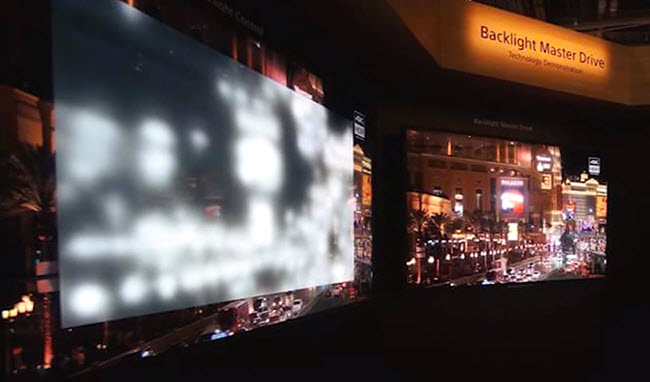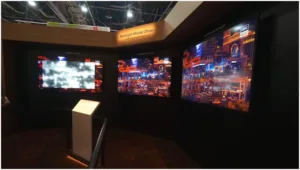At CES, Sony announced a new TV, which included Backlight Master Drive, a technique, which improves contrast ratio and minimizes the effects of dimming on high brightness portions of images and it has now launched the product, as the ZD9 family. The design includes a significant increase in the number of LEDs, and narrows the focus of the dimming algorithms, reducing the averaging (or smoothing) which takes place with a smaller number of LEDs.

While this TV still uses an LCD display device, it could be a forerunner to a micro LED TV that can compete with OLEDs. While the new Sony TV isn’t quite as good as an OLED*, a 65″ TV will sell for $7,000 or 1.75 times the price of an OLED TV. Sony should be able to reduce the cost as volume increases, but they really must move to eliminate the LCD components (polarizers, backlight, liquid crystal, spacers and color filter) in order to compete with OLEDs.
Sony believes it may have just brought the perfect TV to the market by supplying both high luminance and dark blacks. The TV is a kind of hybrid LCD/Micro LED.
The flagship Z series is built around a soup-to-nuts redesign of a full-array LED backlight system. It includes more LEDs, brighter LEDs, more-focused LEDs, and LEDs that can be controlled individually. The backplane is likely sourced from AUO and uses IGZO, since Sony doesn’t own a fab large enough to build a large area TV backplane. However, although these sets still can’t offer the pixel-level control of an OLED TV, they purportedly get closer than any LCD TV ever.
By increasing the number of LEDs in the backlight and making their beams more point sources than flashlights, each one supplies the light for fewer pixels. As such, turning those LEDs on and off controls contrast more finely; bright pixels can appear next to dark pixels with less light leakage. Compared to a full-array backlight with local dimming—traditionally the best LCD technology for contrast performance—Sony’s lighting and dimming systems are more granular.
So how many more LEDs are there? Sony won’t say, but it is likely in the thousands, or even tens of thousands. A 4k micro LED system without progressive scan would require 11 million LEDs. Such a system might also require a bit of redundancy depending on the reliability of the micro LEDs. The system is called “Backlight Master Drive,” and Sony first demoed the technology in a prototype at CES with the label “crystal display”. That prototype TV churned out 1,000 nits of luminance while keeping dark areas of the scene impressively black.
The brightest sets available in stores today—HDR sets that ramp up the nits to boost contrast and highlights—pump out around 1,455 nits. LG’s flagship HDR-capable OLED set, the G6, produces around 600 nits but the brightness is double the luminance (see Barry’s previous article Can’t Stop Drinking the QD “Kool-Aid” for references to this claim – BR). When the Z series sets ship this summer, they won’t have the same kind of luminance power as that CES prototype. However, Sony believes the new TVs will be brighter than any LCD set on the market.
 Sony showed how the new backlight illuminates the image (left)
Sony showed how the new backlight illuminates the image (left)
The other specs are predictably high-end: they’re 4k panels with HDR capabilities and a new image-processing engine designed to boost the color gamut and realism of onscreen images. Android TV and Google Cast features are built right in. When it comes to HDR content, these sets only support HDR10, not Dolby. These models are certainly priced higher than comparable OLEDs. They’re available for preorder now, and the 65-inch XBR Z9D costs $7,000. Unfortunately, that’s the lowest-priced model: There’s a 75-inch version for $10,000 and an upcoming 100-inch version. Sony’s still trying to calculate a price for that last one.
What Sony seems to have done is to design a TV that is almost as good as an OLED, thereby evangelizing the better performance of OLEDs, while marginalizing the only benefit of LCDs – a lower price. Nice going, Sony, and thanks for helping the OLED community.
On a more serious note, Sony has taken the first step toward a micro LED TV. While Backlight Master Drive improves the contrast and reduces the impact of local dimming on very bright images, it is still stuck with LCD issues of slow response time, poor color accuracy, contrast degradation at wide viewing angles and thicker form factors. However, Sony is learning how to deal with more LEDs and how to direct the LEDs to enhance the image.
This TV still has the polarizers, liquid crystal, spacers, color filters and a more expensive backlight. Could the next step in the evolution of this product be a pure Micro LED, which would provide perfect contrast, fast response time, perfect viewing angle images and the lowest power consumption? The issue obviously will be cost and how Sony can pick and place or imprint ~11m LEDs to support 4k resolution, and whether the LED industry can produce efficient and accurate green and red LEDs – or will a color filter still be required?
If Sony is able to take the technology to full micro LEDs with a cost effective placement process, they can regain the leadership position in TVs.
* Barry Young is CEO of the OLED Association

